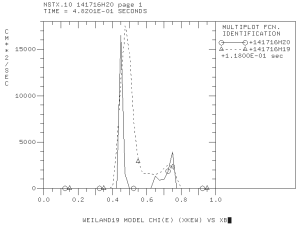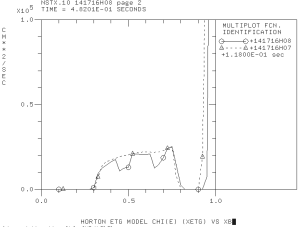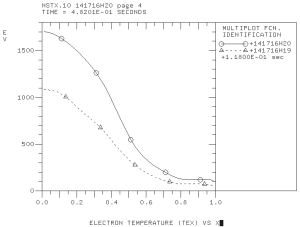Summary of recent TRANSP runs
Here is the summary of recent PTRANSP runs
| Case # | Description | Comments |
|---|---|---|
| 141716H09/10 | ExB flow shear is enabled for W19 and disabled for DRIBM | |
| 141716H11/12 | ExB flow shear is disabled for W19 and DRIBM | |
| 141716H13/14 | MMM95 is used instead of MMM7.1 | relatively small changes in diffusivities |
| 141716H17/18 | MMM7.1 with ExB flow shear effect for DRIBM | ITG/TEM diffusivities goes almost to zero with current levels ExB flow shear effects |
| 141716H19/20 | ExB flow shear factor is reduced from 1 to 0.5 for W19 and DRIBM | see comment below |
| 141716H21/22 | flow shear factor is increased from 0.5 to 0.75 | |
| 141716H23/24 | |
see comments below |
| 141716H25/26 | flow shear factor is reduced from 0.75 to 0.5 for W19 and to 0.1 for DRIBM | see comments below |
There are various definitions of including the Hahm-Burrell and Waltz-Miller definitions. The flow shear rates computed using different definitions are often varied by a factor of 2 or more. The effect of ExB flow shear on particular modes in tokamak even is less certain and requires detailed studies. I plan to vary the ExB flow shear factor from 0.1 to 1 in my simulations depending on the scales of particular modes. In particular, I reduce the ExB flow shear factor to 0.1, when I change
from 0.2 to 2, but I keet the ExB flow shear factor 0.5 for W19 that has
in the PTRANSP simulations 141716H25 and 141716H26.
Some results from my PTRANSP simulations are below.
Case 141716H19/20

The effect of ExB flow shear is clearly visible if these results are compared with the results from the case 141761H11/12 that does not take into account the ExB flow shear effect for W19:

Without the ExB flow shear, the ITG/TEM modes become more unstable at later time. Account for the ExB flow shear makes these modes more stable at the later time.
Case 141716H23/24

Reduction of the characteristic scales of modes with increased from 0.2 to 2.0 resulted in a significant level of anomalous transport in the plasma core that has not predicted with the W19 or DRIBM model with the default
parameters. The ExB flow shear factor should be probably less in these simulations because such short-scale modes should not be affected by the ExB flow shear at the same level as modes with
. I reduced the ExB flow shear factor for these modes from 0.5 to 0.1 in the next case 141716H25/26.
Case 141716H25/26




